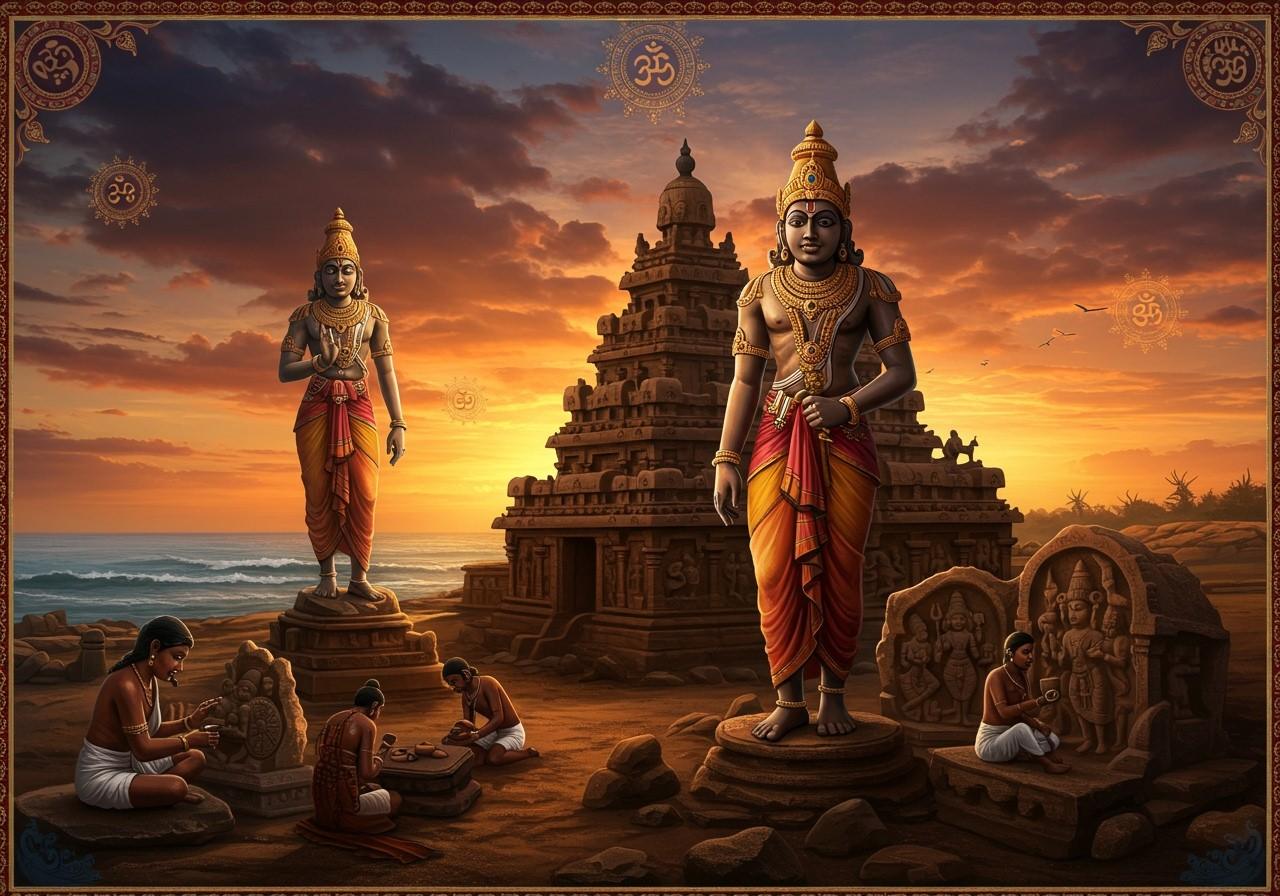
Narasimhavarman I, also known as Mamalla, reigned as a prominent Pallava king in South India from 630 to 668 CE. His rule was a golden age, marked by significant advancements in culture, architecture, art, and religion. This article explores his enduring contributions and their lasting impact on the cultural landscape of the region. Narasimhavarman I’s court buzzed with intellectual and artistic activity, playing a pivotal role in shaping the region’s identity.
Architectural Innovations
Narasimhavarman I spearheaded a distinctive architectural style that transformed South India. This era witnessed the development of rock-cut temples and monolithic structures, showcasing the Pallavas’ innovative approach.
Shore Temple: An Architectural Marvel
The Shore Temple at Mahabalipuram stands as an iconic example of Pallava architecture. A UNESCO World Heritage site, it beautifully showcases Dravidian architectural elements like vimanas (temple towers) and gopurams (gateway towers), blending seamlessly with the coastal landscape. This structural marvel, constructed in the early 8th century, testifies to the architectural prowess of the Pallavas.
Cave Temples and Artistic Intricacies
Cave temples, such as the Mahishasuramardini Cave, are adorned with intricate carvings and sculptures. These rock-cut sanctuaries demonstrate the Pallavas’ mastery of carving techniques. Mandapas (pillared halls), integral to Pallava architecture, served as spaces for religious and social gatherings. The Descent of the Ganges, a massive open-air rock relief in Mahabalipuram, also known as Arjuna’s Penance, is another example of Pallava artistry.
Influence on Later Dynasties
Narasimhavarman I’s architectural style significantly influenced subsequent South Indian dynasties, particularly the Cholas who further developed the Dravidian style. His innovative integration of natural landscapes into temple complexes created a harmonious blend of art and nature, a principle adopted by later rulers.
Dive deeper into Hindu sacred architecture with our comprehensive guide.
Explore Dravidian temple architecture in detail with this insightful resource.
Artistic Contributions
Narasimhavarman I’s reign witnessed a flourishing of artistic expression, particularly in sculpture and painting. The exquisite bas-reliefs at Mahabalipuram narrate mythological stories and scenes from daily life with remarkable detail, offering a glimpse into the cultural fabric of the time.
Sculptural Mastery and Divine Depictions
Pallava sculptors were renowned for their meticulous attention to detail and realism. Divine figures like Vishnu and Shiva, central to Hindu worship, were depicted with intricate craftsmanship, highlighting their religious significance. These sculptures stand as testaments to the artistic skill and spiritual devotion of the era.
The Role of Court Poets and Artists
Court poets like Dandin played a crucial role in promoting Pallava art and culture through their literary works. Frescoes and murals within Pallava temples showcased vibrant colors and captivating narratives, influencing artistic traditions in neighboring regions. These artists, patronized by the king, contributed significantly to the cultural richness of the kingdom.
Nature’s Presence in Pallava Art
The depiction of flora and fauna in Pallava sculptures reflects a deep connection between humans and the natural world. This artistic tradition, emphasizing harmony with nature, extended its influence to Southeast Asia, showcasing the far-reaching impact of Pallava culture.
Religious Developments
Narasimhavarman I’s reign saw significant religious developments, marked by the construction of temples dedicated to various deities. This diversity in worship reflected a tolerant and inclusive religious landscape. As the Pallavas transitioned from Jainism and Buddhism to embrace Saivism, this shift had a profound impact on the region’s religious identity.
Harmony of Shaivism and Vaishnavism
Shaivism and Vaishnavism, two major branches of Hinduism, coexisted harmoniously during this period. Temples built under Narasimhavarman I catered to followers of both sects, demonstrating a spirit of religious unity and acceptance. This balance contributed to a rich and diverse spiritual environment.
Community and Rituals
Temple rituals and festivals played a vital role in fostering community cohesion and strengthening religious devotion. These shared experiences brought people together, reinforcing social bonds and shared cultural values. The temples became centers of community life, promoting both spiritual and social harmony.
Patronage and Religious Scholarship
Narasimhavarman I actively supported religious scholars who composed sacred texts, enriching the spiritual life of his subjects and contributing to the development of Hindu religious thought. This royal patronage fostered intellectual and spiritual growth within the kingdom.
Bring home the divine presence of Lord Shiva with our authentic murtis.
Honor the divine couple Radha Krishna with our beautifully crafted bigrahas.
Narasimhavarman I’s Court and Intellectual Life
Narasimhavarman I’s court was a vibrant hub of intellectual and cultural exchange. Court poets like Dandin, author of the “Kavyadarsha,” showcased the literary brilliance of the era. Scholars and philosophers contributed significantly to the intellectual landscape of the Pallava kingdom, influencing religious thought and artistic expression. The king’s patronage of arts and literature created a dynamic environment where different cultural traditions interacted, enriching Pallava culture and extending its influence beyond South India.
Legacy and Lasting Impact
Narasimhavarman I’s legacy continues to resonate through South India’s cultural heritage. His architectural innovations, particularly the Dravidian style exemplified by the Shore Temple, have had a lasting impact on temple architecture. Pallava art remains relevant in contemporary culture, inspiring artists and craftsmen. His religious policies influenced the development of Hinduism, promoting a diverse and inclusive spiritual landscape. Pallava temples continue to serve as vibrant centers of cultural activities, hosting festivals and rituals that keep traditions alive. Preservation efforts and UNESCO World Heritage listings recognize the global significance of Pallava monuments. Narasimhavarman I’s reign stands as a testament to a golden age in South Indian history, fostering cultural pride and shaping regional identity.
Experience the rich legacy of the Pallavas. Explore poojn.in’s collection of puja items, sacred texts, and devotional artifacts that connect you to the spiritual traditions of this era. Discover authentic products that honor the divine and enrich your cultural experience.
Visit poojn.in today to discover a world of cultural and religious treasures.


